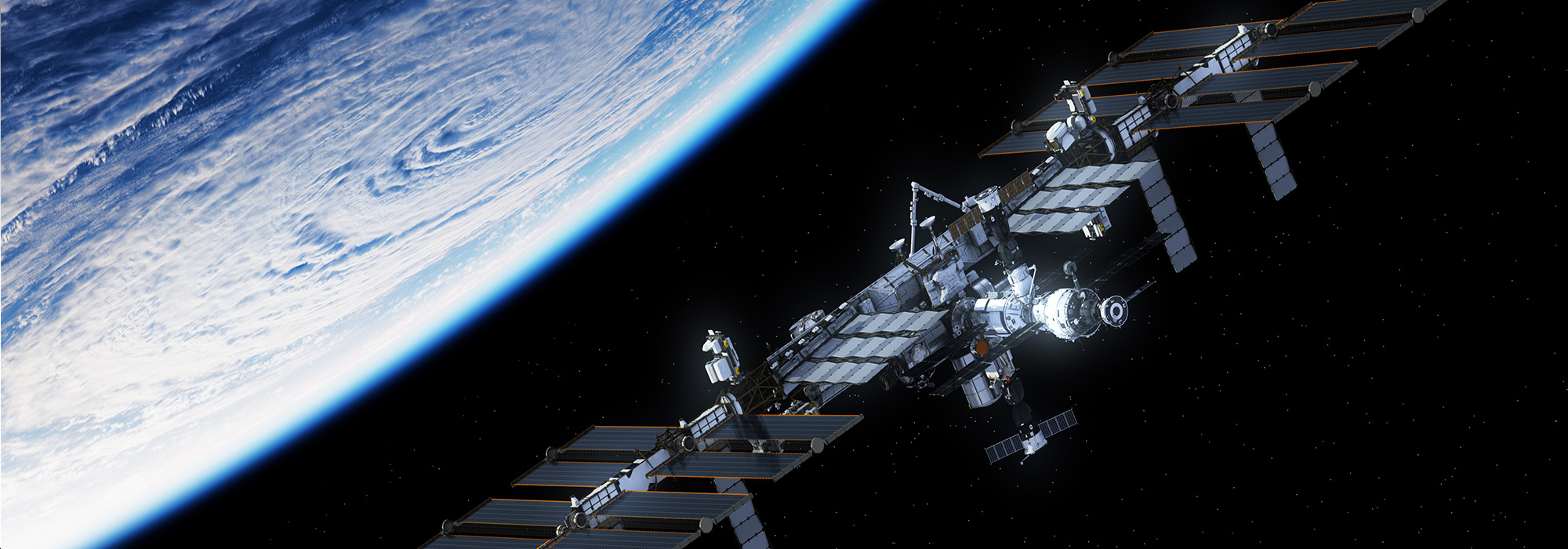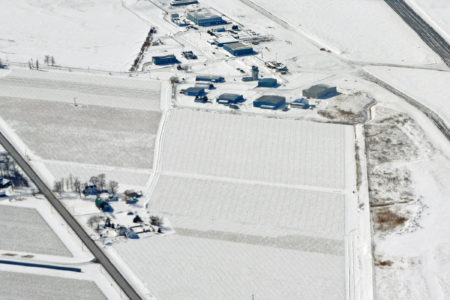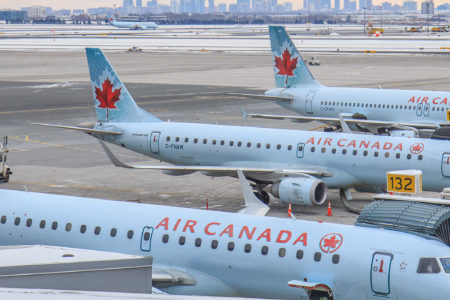
The International Space Station (ISS), which was the subject of last month’s cover section in Policy Options, is currently going through one of its busiest phases ever. Most of its modules have already been built, and this year as many as seven NASA Shuttle missions are planned to deliver components to the Station. It is not surprising then that it has been receiving more press and television than usual lately.
To put the cost of the International Space Station into perspective, consider that according to the US General Accounting Office (GAO) its total cost is now about $95 billion. This involves two main expenses: the actual design and construction of the components themselves by more than a dozen countries, and their delivery by the Space Shuttle for installation in orbit. The total design and construction cost will be about $75 billion while the delivery cost for 40 to 50 Shuttle flights, at about $450 million each, will be about $20 billion. Against this backdrop, Canada’s involvement—supplying robotics equipment, visual systems, and the occasional astronaut, for about $60 million annually according to Canadian Space Agency President William Macdonald Evans—is trivial. Unfortunately, from the perspective of Canada’s space program, $60 million is not insignificant and so any decisions made about allocating funds are critical. In the end, Canada’s space decisions are pragmatic and are based on what can be done with the funds available rather than what Canadians should or would be doing in space in an ideal world. They are also evidently determined by the priorities of other countries’ space programs, particularly, when the ISS is involved, those of the US. In effect, the niche market strategy borrowed from Canada’s telecommunications and other industries has been grafted, if not forced, onto the space program.
Since all the engineering design, manufacturing, test and delivery of the robotic arms has been completed, the issue of Canadian participation in the ISS should seem moot. What remain, as Mr. Evans explained in the interview, are two lesser activities: the astronaut program, in which trained astronauts ride the Space Shuttle to the ISS to perform work or experiments, and the repair and overhaul of the robotic equipment. But the ISS will not be completed before 2005 or 2006 at the earliest and it will have an expected lifetime of perhaps 10 to 15 years. It is unclear when the 10to 15-year clock actually starts ticking or what the contract terms are, but Canada’s space agency could be looking at spending the 20 per cent of its annual budget that our $60 million a year ISS contribution represents every year for another decade or two just to support the ISS. An inflation rate of four per cent would more than double the cost to over $130 million per year by 2020. If the space program budget is not indexed to inflation, the CSA could eventually be spending as much as 40 per cent of its budget simply to help maintain aging obsolete equipment.
Do the Space Station’s benefits justify its costs? If the Canadarm project really has provided “a six-to-one return on the government’s investment in terms of sales,” as Mr. Macdonald argues, the answer would seem obvious—until it is realized that there is no other project at the moment that requires a robotic arm, or that can generate such a return. Nor will there be another in the foreseeable future. Like the Space Shuttles themselves, the arms are large and bulky with no other current purpose than supporting ISS construction and maintenance. There is also the question of what return may be realized for the new generation robotic equipment and space vision system installed on the ISS. These are also sophisticated tools with no real application anywhere else in the world. Together with over 100 major components from more than a dozen other countries, they were not sold but donated to the ISS in return for future considerations.
The argument that spin-off technologies and other benefits derived from their use on the Space Station need to be included in the cost/benefit calculations is weak. One of the principal spin-off benefits identified for Canada in the interview with Mr. Macdonald is a totally automated gasoline station, but it is entirely conceivable that, even without the Canadarm, this technology could have, should have, and would have been developed by oil companies on their own, and at their own cost.
Stephen Strauss quite rightly raised a question about Canada’s supposed expertise in robotics. Canada was able to secure the Canadarm and the ISS contracts during the Cold War, when countries like the former Soviet Union and China were security risks, while Japan and other European countries had no space programs to speak of. Today, however, the Cold War is history and these countries have sizeable space programs that include next-generation research into microrobots and extremely small nano-robots. The specific technological advantages that Canada had with the robotics technologies of the Canadarm and the ISS are now being been matched or superseded. As NASA leads the drive to commercialize the Space Station, and as governments move out of the industry, future contracts will tend to be awarded for competitive as well as political reasons. Given Canada’s traditionally non-aggressive marketing methods, its niche in the robotics business looks far from secure. Yet if the initial investment cannot be followed up, it will not provide the downstream benefit that is supposed to make it worthwhile.
Another often-hoped-for benefit of the ISS is that it can be used to grow large protein crystals, the study of which could lead to new medicines. Yet Francis Slakey, associate director of public affairs for the American Physical Society, wrote in a 1999 Scientific American article on the future of space exploration that “… in July 1998 the American Society for Cell Biology bluntly called for the cancellation of the crystallography program,” saying that “proposed experiments were not likely to make any serious contributions to the knowledge of protein structure.” Despite the scientific community’s disapproval, NASA plans to go ahead with the experiments.
NASA’s slow, even ponderous development of the Space Station seems intended to remove the risks of exploring space and to make accessing this new environment completely safe for humans. Despite the project’s internal identity conflict over whether to be a commercial venture or a scientific endeavour, it is hoped that life-science experiments will help solve important health problems of long-term exposure to zero gravity (e.g., bone loss and muscle atrophy) and to solar radiation. The utility of these goals is questionable however. Muscle atrophy can be minimized or eliminated by artificial gravity and exercise. In his widely read book The Case for Mars, Robert Zubrin, an astronautical engineer and former senior engineer at Lockheed Martin, described the use of artificial gravity in detail and characterized the “continued experimentation on humans with long-duration, zero-gravity health effects as unethical and worthless.” In the 1999 Scientific American issue on the future of space exploration mentioned earlier, staff writer Tim Beardsley wrote that “… a vehicle designed to go to Mars could easily be furnished with artificial gravity by separating it into two connected sections and slowing spinning them.” On the solar radiation issue, Beardsley noted that “… the [space] station’s orbit is too low to experience the full fury of solar storms.” On some of the most critical research issues it will be involved in, the $60 to $100-billion ISS evidently will be generating redundant or inconclusive experimental results.
Over the last 30 years, since the final manned Moon mission in 1972, astronauts and cosmonauts have circled the globe many thousands of times. Russian cosmonauts on the Mir space station lived in zero gravity exposed to solar radiation for periods of more than a year at a time and came back safe and healthy so long as they followed the proper exercise regimen. The massive amounts of data collected on these missions over the years have provided enough information about the effects of micro-gravity on humans to allow manned exploration to begin.
Based on unofficial statements from CSA personnel, the annual cost of the astronaut program is minimal. All the glossy photos and television images of Canadian astronauts floating in zero gravity apparently come at minimal cost. While this may be true, there is a downside to the program that is usually ignored. To most people, it sends the distorted impression that the exploration and development of space is a fun, safe, low-risk activity. It is certainly portrayed as a wonderful exhilarating experience, which I am sure it is. But the easy manner of our astronauts during press conferences belies the amount of work they have done and the demanding qualifications they have had to meet. At a career level, university students rapidly become disillusioned as they graduate and find that because of budget constraints, Canada’s space program really is little more than a handful of astronauts, some robotics equipment for the Space Station and the Shuttle, and a few commercial satellites that are both manufactured and launched abroad. The country has no spacecraft design and manufacturing facilities, no launch capability, no operations or mission planning, and no planetary science centres. With no well-developed space exploration and development program, and perhaps not even sufficient infrastructure to start one, scientists, engineers and potential managers educated in Canada at a cost of millions of dollars to taxpayers either leave the field altogether or pursue their space career in another country. In Canada, these issues are fodder for critics who see the CSA as an organization that, like NASA, is often more preoccupied with image than substance. This makes it difficult to secure adequate funding for useful projects or to acquire an appropriate level of credibility. The situation is aggravated by the reality of a Canadian public that feels funding the development of a space industry is not the right thing to do. There are other priorities like health care and medical research, and as Stephen Strauss asks, what’s there to see or do on the Moon or Mars anyway?
With all due respect, the correct answer to the last question is not “nothing.” Consider a comparison between health care and medical research on the one hand, and environmental work and space exploration on the other. Health care attends to the daily, short-term physical and psychological problems of individuals, while medical research addresses long-term solutions. Environmental studies and research on a global scale similarly address the short-term and long-term health of the planet. However, the environment today is more than just the Earth’s atmosphere and the ground below us. It now includes the Sun, the planets and in a very important way the asteroids and comets. The exploration of this external environment is a relatively new field called planetary science and it acquires its research data and information by sending out spacecraft beyond Earth”˜s atmosphere into deep space. What are its benefits?
As a result of dozens of spacecraft having been sent to the planet Venus in the 1960s, 1970s and 1980s to study that planet’s carbon-dioxide atmosphere and surface geology, an understanding was developed of greenhouse warming and acid rain formation on the Earth. From Viking and Mariner spacecraft sent to Mars in the 1970s to study the huge dust storms that covered the entire planet for months came the realization that a nuclear war would lead to radiation-laden dust clouds covering the planet, resulting in a “nuclear winter” that could destroy civilization. This newly acquired knowledge had a strong sobering effect on US and Soviet political and military leaders during the Cold War. More recent events that teach similar lessons include the much-publicized cataclysmic collision of comet Shoemaker-Levy 9 with the planet Jupiter in 1994, and the discovery that mass extinctions of species including the dinosaurs were likely caused by comets and asteroids hitting Earth. In view of the damage such collisions can do it is crucial that we learn as much as possible about asteroids and comets as soon as is humanly possible. That dead piece of dusty rock we know as the Moon may never be able to independently support human life but it may one day be home to large telescopes operating free of earthquakelike vibrations, stabilizing rocket engine firings and distorting atmospheres while it monitors Earth’s immediate space for threatening asteroids and comets.
The US spends enormous amounts of money on the Space Station, but it also spends on planetary science, as the very successful Mars Pathfinder, Galileo and Mars Global Surveyor missions have shown. Even so, for the tens of billions of dollars it spends on the ISS, it spends only hundreds of millions on space exploration. That may not be enough but at least it is something. In Canada, the planetary exploration budget is effectively nil, amounting to perhaps $10 million a year—while fully $60 million per year is spent on a project whose benefits seem only marginal, and in certain cases only hoped for. The CSA is vague when providing details on the remaining 75 per cent of its $300 million budget, but activities fall into categories such as supporting Radarsat (an Earth observation spacecraft and program that is now privatized), equipment testing at the David Florida Lab in Ottawa, and other generalized expenses labelled as space technology for spacecraft, education/awareness and infrastructure.
Rather than continually inventing ways to put a positive spin on the cost/benefit ratio of the ISS, more attention should be given to comparing the cost/benefit ratio of the ISS with other space exploration projects and then acting accordingly. For the $450 million that a single Shuttle launch costs, a complete unmanned space science mission, including engineering design, fabrication, launch, operations and data analysis can be undertaken. This would be true for any Earth remote sensing or planetary science mission to almost any planet, moon, asteroid or comet in the solar system. For the total global cost of the Station, between 100 and 200 unmanned missions could have been flown. They likely would have produced much more useful data for humanity than the ISS will.
Speaking at the International Space Development Conference in Houston, Texas, in May 1999, Mr. Barry Waddell, a NASA business manager for the ISS stated that NASA was in the process of commercializing 30 per cent of the ISS—more if the demand is there, since no upper limit was specified. Almost two years later Molly Macauley wrote in the January 29, 2001 issue of Space News: “NASA’s posted price list for using the space station has attracted only one customer to date.” With no reliable completion date established for the ISS and a fee schedule that may be forced up by cost escalation, it is not clear how any company can confidently formulate a business plan to bring to NASA. If a single launch to the ISS (for space tourists for example) costs a company anywhere from $100 million to almost $500 million, can any business be profitable, and if it is, how long would it take for its investment to be recovered?
The point that Stephen Strauss makes about the one-way movement of goods will be true for some time to come, probably decades. From a practical and commercial point of view, whether for the Space Station, Mars, or the Moon, trade will only begin to develop after the establishment of permanent bases or settlements on the Moon, Mars and a number of asteroids. But that will not happen until launch costs can be reduced from the current $10,000 per kilogram to $100 or $200 per kilogram. Unfortunately, while NASA and other space agencies around the world focus on completing the Space Station, the development of a cheap and effective means of entering space remains a low priority item.
Human exploration of space is not likely to begin for at least another ten or 20 years. Exactly when it does will depend more on successfully reducing transportation and logistical costs than on enabling research from the Space Station. The first human missions to Mars will likely carry individuals with geological or geochemical expertise and even archaeological experience to look for evidence of past life on the planet. Visits will last for several months or a year, not just a few hours. Data from the Mars Global Surveyor currently orbiting Mars has continued to provide strong evidence that Mars was once very Earth-like. It had an atmosphere and oceans and may have harboured primitive microbial life forms for millions of years. Finding microfossils would be strong confirmation that life may be able to spontaneously take hold and develop anywhere in the universe when conditions are right.
Thus any future missions that put humans on Mars are not likely to be the “Look, we did it.” type that Stephen Strauss is apprehensive about, or the “flag and footprints” jaunt Robert Zubrin derisively refers to in his book The Case for Mars. That certainly would not be the case for the Moon, which has already been visited six times by humans and was the big prize during the US-USSR space race. In addition to being an outpost for astronomical telescopes, the Moon could serve in the future as a useful staging area to practice long-duration stays of several months before an assault on Mars.
Within a few yeas, an emerging space power will become only the third nation ever to put humans in space, and will be competing with the US and Russia. On January 16, 2001 the re-entry section of a Chinese Shenzhou-2 spacecraft successfully touched down in Mongolia after one week in orbit. Within one or two years, perhaps in 2002, China expects to launch two taikonauts (Chinese astronauts) into orbit. The Russian economy is still a shambles and years away from full recovery, while NASA’s space program is constantly delayed by legal, political and military concerns. The European Space Agency still expresses little interest in manned exploration, and communist China, with its almost unlimited, relatively cheap and increasingly skilled labour force, is expected to become a serious space power. Depending on whether China’s priorities lie with a military space program, its own space station, or manned and un-manned space exploration, the potential for another space race may be taking shape. What its nature will be remains to be seen.
Amidst all these developments, Canada plods along with a $60-million Space Station budget that looks extremely inconsequential. The government and the CSA wonder about which projects and which countries its modest $300 million should be backing. Since their niche market philosophy usually results in small add-on experiments or projects piggy-backed onto various large US, Japanese and European missions, successes and rationales will tend to reflect those of the host nation. History and geography suggest that, for better or worse, we will continue to follow US policy in space-related matters and support projects like the ISS. For the reasons outline above, this is not the best strategy. Alternatives are doable. They require increased funding, which Canada can now afford, but to advance in this direction, we need to exhibit considerably more independence, initiative and imagination than we have shown in the past.
Photo: Shutterstock






